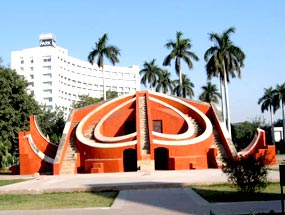Jantar Mantar of New Delhi counts amongst the
oldest astronomical observatories of the world. Explore Jantar
Mantar of Delhi, India.
Jantar Mantar Delhi

Location: Parliament Street, Near Connaught
Place (New Delhi)
Founded By: Maharaja Jai Singh II of Jaipur
Founded In: 1724
Timings: Sunrise to Sunset (Daily)
Type of Structure: An Astronomical Observatory
Status: Protected Monument under ASI Act
Interesting Facts: Jantar Mantar was the logo of the 1982 Asian
Games
Jantar Mantar of New Delhi is one of the oldest astronomical
observatories in India as well as the world. It is situated at a
distance of approximately 250 meters from the famous shopping center of
Connaught Place. The observatory dates back to the year 1724 and was
built under the patronage of Maharaja Jai Singh II of Jaipur. He built
the Jantar Mantar of Delhi after studying Hindu, and Muslim astronomical
works thoroughly. It serves as perfect example of the technological
innovations of that time.
Jantar Mantar of Delhi is one of the five observatories that were built
by Sawai Jai Singh II. The other four observatories are located in the
cities of Jaipur, Varanasi, Ujjain and Mathura. All these observatories
were built somewhere between 1724 and 1730. There is a very interesting
story behind the establishment of the Jantar Mantar of Delhi. Jai Singh
was very much interested in two things - art and science, mainly
astronomy. He once heard an argument between the Hindu and Muslim
astrologers at the court of Muhammad Shah.
They were fighting over the issue of certain planetary positions. The
positions were to be known with accuracy so as to arrive on an
auspicious hour for the emperor to go on a mission. Jai Singh offered
his help in rectifying the available astronomical tables. The Mughal
emperor readily accepted the offer and this incident led to the
construction of Jantar Mantar in Delhi, where the movements of the
celestial bodies, including sun, moon and planets could be observed.
There are six main instruments inside the Jantar Mantar Observatory.
Samrat-Yantra
The most important instrument kept inside Jantar Mantar is
Samrat-Yantra, a huge sundial. It is an equinoctial (equal hour) dial,
which comprises of a triangular gnomon. The hypotenuse of the gnomon is
parallel to the earth's axis. Either side of the gnomon is attached with
a quadrant of a circle, which is parallel to the plane of equator.
Jai Prakash Yantra
Jai Prakash Yantra is used to determine the position of Sun, along with
other heavenly bodies. This instrument was designed by Jai Singh and is
made up of two concave hemispherical structures.
Ram Yantra
To the south of the Jai Prakash Yantra is Ram Yantra. A circular
structure, it has a tall pillar in the middle. Jai Prakash Yantra was
used for reading azimuth (horizontal) and altitude (vertical) angles.
Misra Yantra
Misra Yantra, a combination instrument, is sited to the northwest of
Ram Yantra. The instrument is so called since it comprises of a number
of instruments in one. It is much similar in appearance to the stylized
'namaste', the Indian form of greeting. The Niyta-Chakra of Misra Yantra
indicates Greenwich, Zurich, Notkey (Japan) and Serichew (Pacific Ocean)
meridians.
Dakshinottarabhitti Yantra
Dakshinottarabhitti Yantra is the instrument that was used for
obtaining meridian altitudes. The Karka-rasi-valaya of the instrument
revealed the entry of the Sun in Cancer constellation.
Agra Yantra
Agra Yantra is the second quadrant on the west side of the building. It
is not known for what purpose was the instrument used.
Almost all the instruments mentioned above are not functional today.
This is because the markings as well as the floor measurements of the
instruments have become distorted over time. A temple of Lord Bhairava,
probably constructed by Maharaja Jai Singh, is situated to the eastern
side of the instruments. Surrounding the instruments are blooming
gardens, which are adorned with seasonal flowers. Jantar Mantar is
maintained by the Archeological Survey of India (ASI) and has been
declared as a protected monument under the ASI Act.


